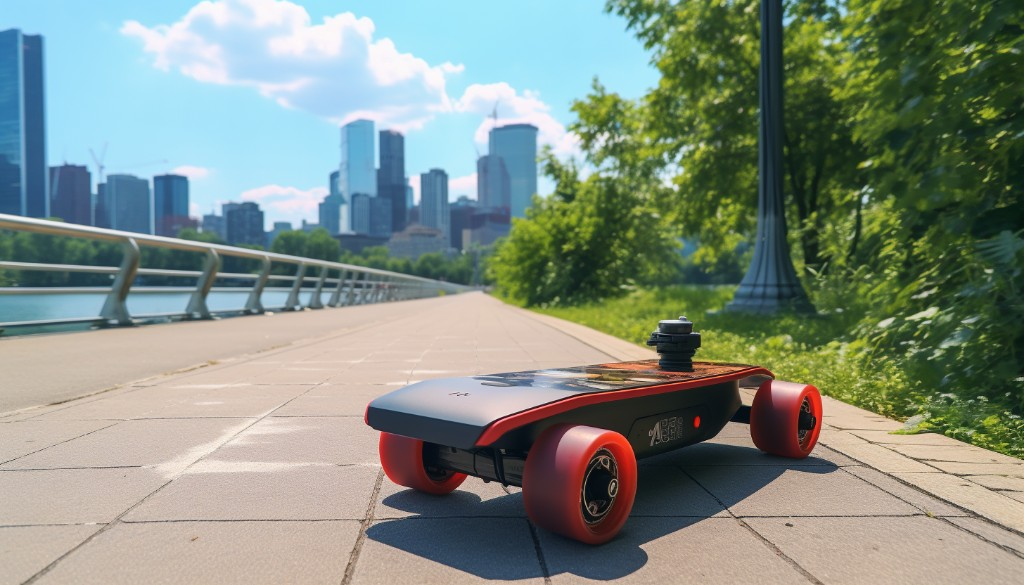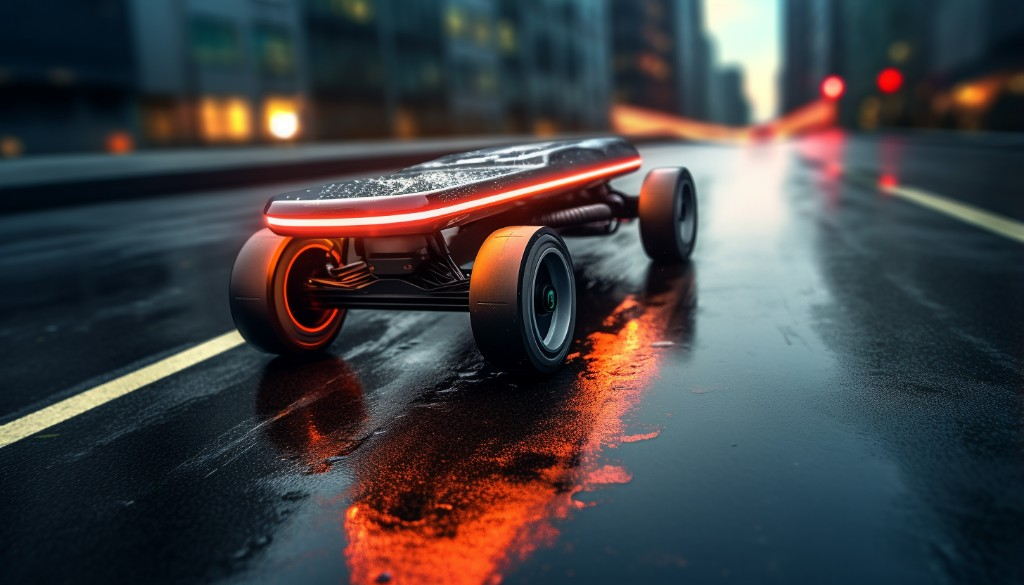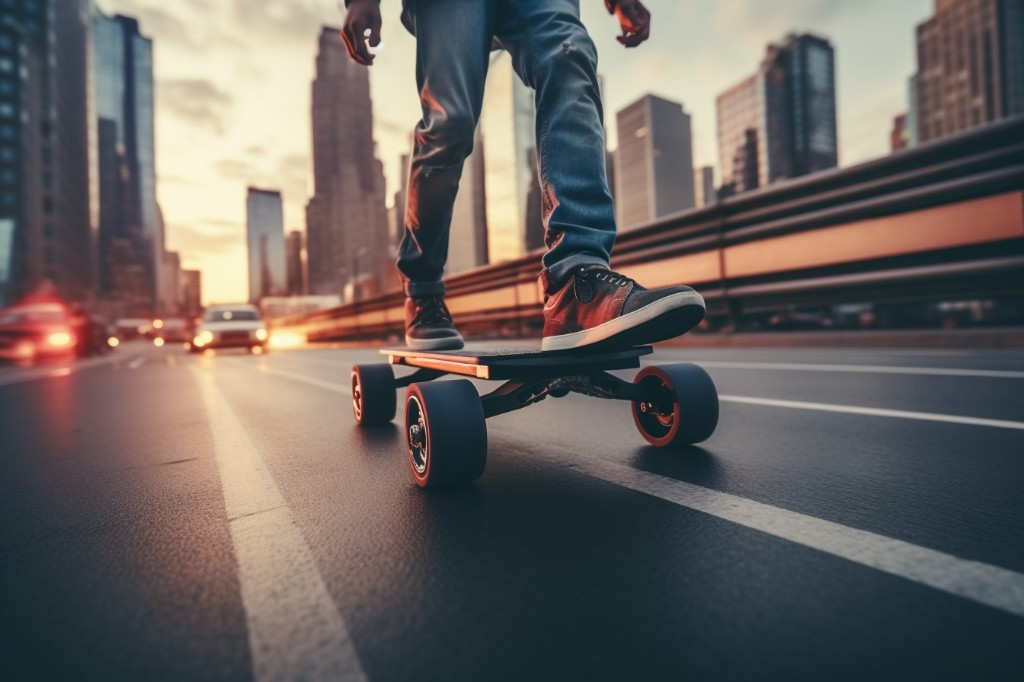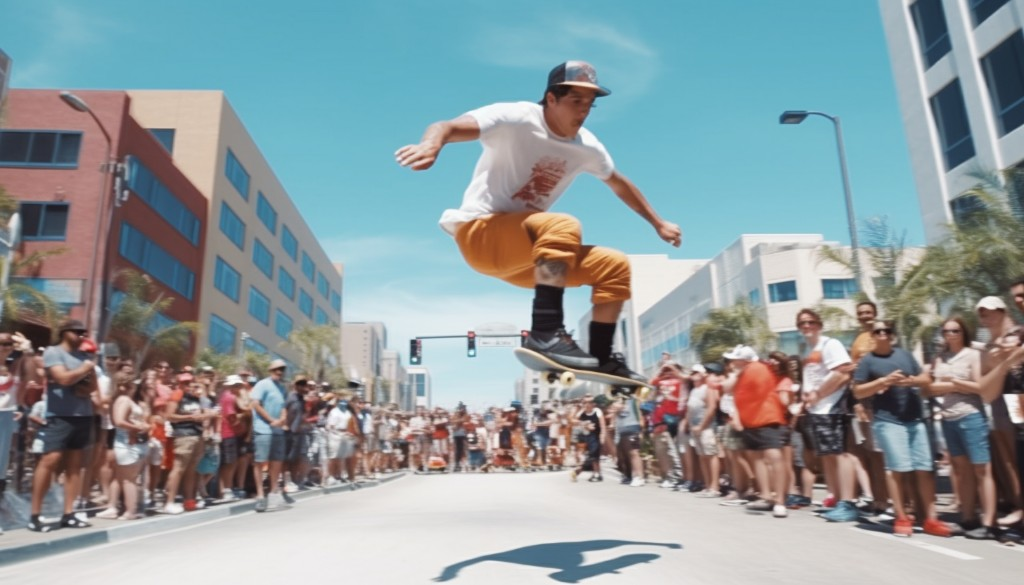Imagine cruising through city streets, effortlessly gliding past traffic, feeling the thrill of acceleration at your fingertips. No, you’re not dreaming – you’re aboard an electric skateboard, a marvel of modern technology that has revolutionized personal transportation. But have you ever wondered how this ingenious device came to be? Who were the pioneers who turned the dream of powered skateboarding into reality? How has the technology evolved over the years and what does the future hold?
What we’ll cover:
- Skateboarding’s Origins & E-Skateboarding’s Emergence
- Pioneers Behind E-Skateboarding
- The Technological Evolution of E-Skateboards
- Impact & Influence of E-Skateboards
- Peeking into the Future of E-Skateboarding
Let’s dive into this exciting journey through history, innovation, and impact. Hold onto your helmets, it’s going to be a thrilling ride!
The Origin of Skateboarding and the Emergence of Electric Skateboards
In the early 1950s, a wave of creativity swept over Southern California, giving birth to the first skateboards. The idea was simple: attach roller skate wheels to a wooden board, and voila! Skateboarding was born. These early skateboards were crude and lacked the refinement and sophistication of today’s boards, but they were the genesis of a global phenomenon that would forever change the landscape of urban transportation.
Fast forward a few decades, and we see the birth of motorized skateboards. Yes, you heard that right, motorized skateboards! It was an audacious attempt to merge the thrill of skateboarding with the convenience of motorization. They were essentially skateboards made by attaching a small gasoline engine to the rear end. Although these early models were noisy and cumbersome, they paved the way for what was to come – electric skateboards.

The concept of an electric skateboard was a revolutionary idea that emerged from the intersection of skateboarding culture and technological innovation.
The idea was to attach electric motors and batteries to skateboards, thereby providing an efficient and eco-friendly mode of personal transportation. It took a few years for technology to catch up with the concept, but when it did, the electric skateboard became a reality.
Pioneers of Electric Skateboarding
The early years of electric skateboarding were marked by a spirit of innovation and experimentation. Among the pioneers was a young student in Berkeley, California named Louie Finkle. Often credited with creating the first wireless electric skateboard, Finkle’s invention was nothing short of groundbreaking. He was able to combine his passion for skateboarding with his knowledge of electronics to create a device that was both practical and fun. His skateboard was powered by a rechargeable battery and controlled wirelessly, making it a precursor to the modern electric skateboard.
Around the same time, another pioneer was making waves in the world of skateboarding. Jim Rugroden, a mechanical engineer by trade, was also exploring the concept of e-skateboards. Rugroden’s contribution to skateboard design was significant. He developed a unique drivetrain that allowed for smoother and more efficient power transfer from the motor to the wheels. His design principles still influence many e-skateboard designs today.

These pioneers paved the way for the modern electric skateboard industry. Their tireless efforts and relentless pursuit of innovation laid the foundation for an industry that has grown exponentially over the years. The electric skateboard has come a long way from its humble beginnings, and it’s all thanks to these visionaries who dared to dream big.
As technology advanced, so did the design and functionality of electric skateboards. From those early days of crude motorized boards to the sleek and sophisticated models we see today, the evolution of electric skateboards is a testament to human ingenuity and the spirit of innovation. From students in Berkeley to mechanical engineers, each person has played a crucial role in shaping this fascinating piece of our cultural history.
Evolution of Electric Skateboard Technology
The journey of e-skateboarding from its humble beginnings to the adrenaline-pumping marvel we have today has been nothing short of a thrilling ride. I still remember the early days when skateboards were nothing more than planks of wood bolted onto metal roller skates. A far cry from the sophisticated machines we see today.
In those early days, skateboards made do with what was available. The boards were crude and the metal roller skates served as makeshift wheels. It was an era of invention born out of necessity. But as the years rolled on, so did the evolution of skateboarding technology.
As the popularity of skateboarding grew, so did the need for better, safer, and more efficient boards. Enter electric skateboards. Powered by advanced motors and batteries, these boards marked a significant leap in skateboard technology. They offered a new level of control and speed, often exceeding 20 miles per hour.

What’s more, the current e-skateboards are a testament to how far we’ve come. They’re equipped with high-capacity batteries that offer longer rides and brushless motors that provide smooth acceleration and deceleration. Some even come with regenerative braking systems that convert kinetic energy back into battery power.
In essence, e-skateboarding has evolved from a simple pastime to a legitimate mode of transportation, thanks to advances in technology. The strides made in battery and motor technology have been particularly significant in shaping the current state of e-skateboarding.

Kickstarter Campaigns and the Rise of Electric Skateboarding Brands
With the advent of crowdfunding platforms like Kickstarter, it was only a matter of time before e-skateboarding caught the wave. Kickstarter campaigns played a pivotal role in the rise of prominent electric skateboarding brands, most notably Boosted Boards.
Boosted Boards, a name synonymous with electric skateboarding, owes a lot of its success to its Kickstarter campaign. The campaign not only helped raise the necessary funds but also garnered a lot of attention and interest from potential users. It was through this platform that Boosted Boards was able to showcase its innovative approach to e-skateboarding, which resonated with many skateboard enthusiasts.
The success of Boosted Boards inspired other brands to take the same route, leading to an influx of electric skateboard brands on the market. This, in turn, contributed to the popularity and accessibility of electric skateboards.
Today, you’ll find a myriad of brands offering electric skateboards with varying features and price points, all thanks to the crowdfunding culture fostered by platforms like Kickstarter. This means there is an electric skateboard for all budgets!

But it’s not just about the rise of brands. These Kickstarter campaigns have also served as a platform for innovation. They’ve encouraged inventors and entrepreneurs to think outside the box and push the boundaries of what’s possible with e-skateboards.
So, whether you’re a thrill-seeker looking for your next adventure or a commuter searching for an eco-friendly transportation alternative, there’s an electric skateboard out there that’s perfect for you. And it’s all thanks to the evolution of skateboard technology and the rise of brands driven by platforms like Kickstarter.
Impact and Influence of Electric Skateboards
As we venture into the realm of the impact e-skateboarding has had, it’s impossible to overlook how they’ve revolutionized urban areas. Imagine a busy city street, cars honking, people rushing about, and in the midst of it all, a few nimble riders whizzing by on their electric skateboards. It’s not an uncommon sight these days, especially in bustling metropolises like Los Angeles.
Electric skateboarding has emerged as a viable alternative for commuting in urban areas, proving to be not just eco-friendly but also a time-saving solution for beating traffic congestion. They’re compact, portable, and can navigate tight corners or narrow lanes with ease. This shift towards smaller, personal electric vehicles has even led to changes in urban planning. More cities are now incorporating electric skateboard-friendly infrastructure, such as dedicated lanes and parking areas.
But the road to acceptance hasn’t been entirely smooth. The rise of e-skateboarding has also led to a need for new legislation. Authorities have had to grapple with how to regulate these new modes of transport, leading to electric skateboard legislation being put into place in many jurisdictions. These laws address issues such as speed limits, helmet requirements, and where these boards can be used.

The Role of Electric Skateboards in Sustainability
In a world increasingly conscious of its environmental footprint, e-skateboarding also presents a greener mode of transport. They produce zero emissions, making them a preferred choice for many eco-conscious urban dwellers.
Electric Skateboarding Culture and Community
Beyond its practical applications, e-skateboarding has given birth to an entire culture and community. In fact, there’s a vibrant world surrounding this sport that often goes unnoticed by the uninitiated.
The electric skateboard community is a diverse, inclusive group of individuals bound together by their shared passion. You’ll find forums and social media groups teeming with discussions about the latest gear, tips for beginners, and shared experiences. There are also numerous events and meet-ups where enthusiasts can ride together, exchange knowledge, and form connections.
Electric skateboarding competitions have become another significant aspect of this culture. These events showcase the skills and abilities of riders while promoting the sport to a wider audience. Sponsorships from major brands have helped fuel the growth of these competitions, providing competitors with the chance to turn their passion into a profession.
Moreover, e-skateboarding has also found its way into popular culture, appearing in movies, music videos, and even video games. This exposure has further elevated its status and helped to bring it into mainstream consciousness.
The Power of Representation
The representation of electric skateboarding in media plays a crucial role in shaping public perception. It’s not just about depicting the sport accurately but also about presenting it as a viable, enjoyable, and accessible activity for all.
E-skateboarding isn’t just a mode of transport or a hobby — it’s a lifestyle, a community, and a sport with its own unique culture. The journey from its origins to its current status has been remarkable, and there’s no doubt that it will continue to evolve and influence urban living and popular culture in ways we can’t even imagine yet.

The Future of Electric Skateboarding
I’ve got a hunch that the future of electric skateboarding is not just bright; it’s electric. As we continue to make strides in technological advancements, the electric skateboard industry shows no signs of slowing down. Instead, it’s hurtling forward at breakneck speed, much like a rider down a steep hill on a high-powered electric skateboard.
Technological Advances in Electric Skateboarding
Innovation is the heartbeat of the electric skateboard industry. With the continuous evolution of electric skateboard technology, it’s not surprising that we’re seeing more and more sophisticated boards on the market. Think of it as a new generation of electric skateboards, featuring faster speeds, longer battery life, and enhanced safety features.
Imagine riding an e-skateboard that can reach speeds of up to 30 mph and cover distances of over 20 miles on a single charge. And it doesn’t stop there; newer models are even incorporating AI technology for smart braking systems and automated control. The rider simply needs to lean in the direction they wish to go, and the board does the rest. It’s like having your own personal magic carpet, but with wheels and a motor!
Legislative Changes on the Horizon
While technology is propelling the e-skateboard industry forward, there’s another key player in this game: legislation. As more people hop on their boards and hit the streets, lawmakers are being forced to reconsider current laws and regulations surrounding electric skateboarding.
As it stands now, electric skateboard legislation varies widely from city to city and country to country. Some places welcome these high-tech vehicles with open arms, while others impose strict regulations or outright bans. However, as the popularity of electric skateboarding continues to rise, we may see more uniform laws come into play.
A future where e-skateboards are recognized as legitimate forms of transportation, complete with their own designated lanes, is not so far-fetched. It may even be right around the corner.

The Growth of the Electric Skateboard Industry
When we talk about the future of electric skateboarding, we can’t overlook the potential for significant industry growth. The market is already booming, with more and more companies jumping on the electric skateboard bandwagon.
As the demand for e-skateboards increases, so does the competition. This leads to higher quality products, lower prices, and a wider range of options for consumers. It’s a win-win situation for everyone involved.
But perhaps the most exciting part of this growth is the potential for community expansion. The electric skateboard community is already a vibrant and diverse group of people, and as the industry grows, so too will this community. We’ll see more electric skateboard clubs, events, and competitions, bringing riders together from all walks of life.
So, while we can’t predict the future with absolute certainty, one thing’s for sure: the world of electric skateboarding is just getting started. As technology advances, legislation evolves, and the industry grows, we’re in for a thrilling ride. So strap on your helmet, grab your board, and let’s see where this electrifying journey takes us next.

Closing Thoughts
Electric skateboarding’s history, beginning with its humble origins and emergence, has been a thrilling ride. The pioneers who dared to dream of an innovative and exciting mode of transportation laid the groundwork for the evolution of electric skateboard technology. Their dedication and creativity spurred a revolution that not only transformed the concept of skateboarding but also made a significant impact on urban transport.
Electric skateboards, once a novelty, have now become a crucial part of our urban landscape, influencing our lifestyle, our cities, and our future. As we look ahead, the future of e-skateboarding is bright and full of promise. With continuous technological advancements and increasing societal acceptance, we can expect to see these boards become even more integrated into our daily lives.
Frequently Asked Questions
Who invented the first electric skateboard?
The first electric skateboard was invented by Louis Finkle, an American inventor. Finkle realized the potential of adding a motor to a traditional skateboard and patented his electric skateboard design in 1999.
How has the design of electric skateboards changed over time?
The design of e-skateboards has evolved significantly over time. Initially, they were just traditional skateboards fitted with a motor and a battery. However, with advancements in technology, modern electric skateboards have become more efficient and user-friendly. They now feature lighter materials, more powerful motors, longer battery life, and advanced control systems for improved riding experience.
What role did Kickstarter play in the rise of electric skateboarding?
Kickstarter played a significant role in the rise of e-skateboarding by providing a platform for innovators to raise funds. Many e-skateboard companies, like Boosted Boards, started their journey on Kickstarter. This allowed them to gain public attention and financial support to bring their ideas to life.
How has electric skateboarding impacted urban transport?
Electric skateboarding has greatly impacted urban transport by providing an alternative mode of transportation that is not only fun but also environmentally friendly. E-skateboards are efficient for short distance travel and help reduce traffic congestion. They also promote a more active lifestyle among urban dwellers.
What are some predictions for the future of electric skateboarding?
Predictions for the future of electric skateboarding include advancements in battery technology leading to longer ride times, integration of artificial intelligence for enhanced safety features, and the potential for e-skateboards to become a more common sight in urban transportation due to their efficiency and environmental benefits.
